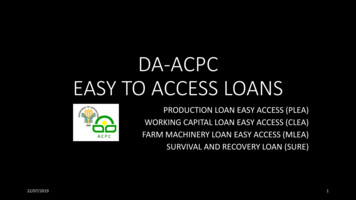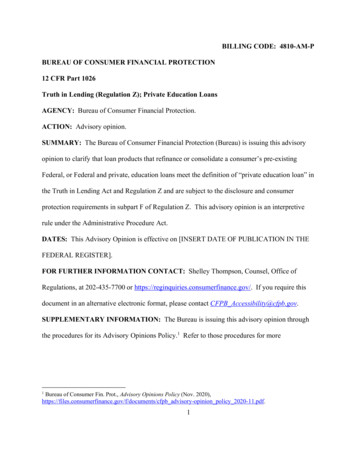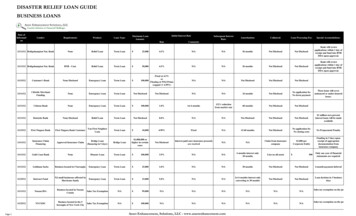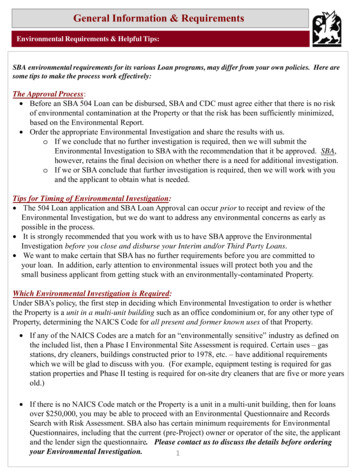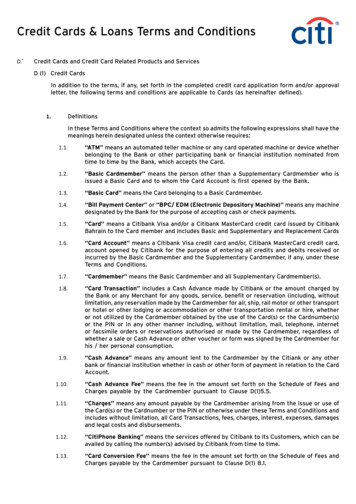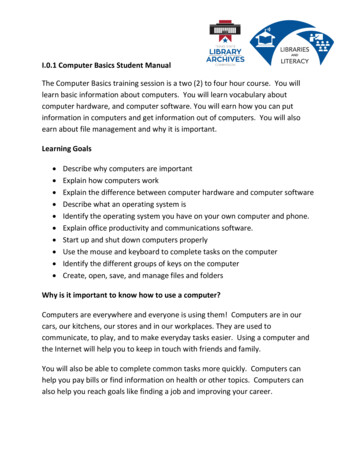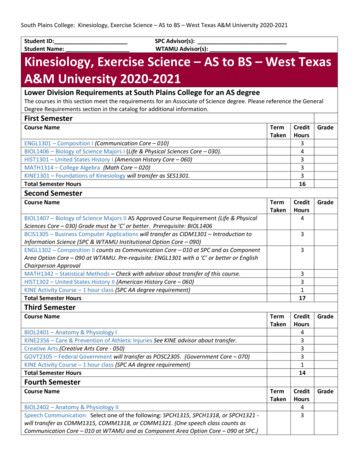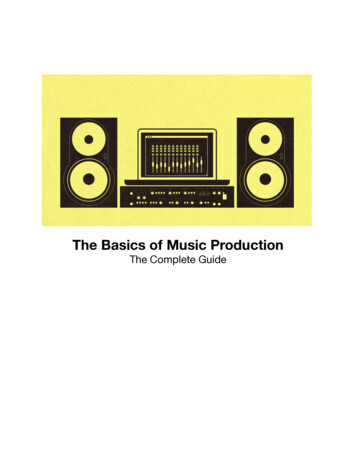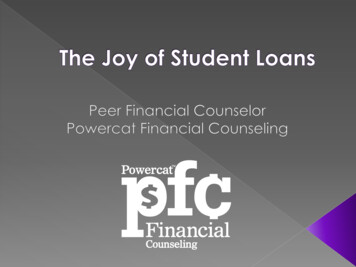
Transcription
The Basics of Student LoansRepayment OptionsRepayment TipsTax and Credit Implications of LoansOnline SALT financial tool can help
Types of loans Federal – backed by the Government Go to www.nslds.ed.gov for a list of federal loans Note: Parent Plus loans are under parent’s SSN KNOW WHO YOUR LOAN SERVICERS ARE!!! Direct federal loans vs. FFEL federal loans Perkins, Stafford unsubsidized, Stafford subsidized,PLUS loans Private Go to www.annualcreditreport.com if unsure oflender Search engine: FASTChoice on OSFA website
Go towww.studentaid.ed.govfor all informationregarding federal studentloans
No payments due now Grace period of 6, 9, or 12 months aftergraduation Remember you have only 1 grace period! In-school deferment (enrolled at least half-time) Interest continues to accrue on unsubsidizedloans (and PLUS loans) If you don’t pay the interest, it may becapitalized and added to the principal atthe end of your grace period
Standard: Fixed payment each monthfor 10 yearsGraduated: Still 10 years, but paymentsstart low, then increase every few yearsExtended: Significantly lower paymentsfor 12-30 years, interest costs increase.
Graduated Extended: Payments startvery low, then increase every 2 yearsover an extended periodIncome-Driven or Pay As You Earn:Monthly payments are based onincome, must confirm annuallyConsolidation: Not a true repaymentplan, but may benefit you
Loan payments capped at percentage ofdiscretionary income› Discretionary income is defined as AGI minus150% of the Poverty Line for the family size› Currently 15% of discretionary income› 0 payment if income 150% of the poverty lineRemaining debt and interest forgiven after25 years in repayment Forgiveness is treated as taxable income
See IBRinfo.org for moreinformation
Eligible if you are a new borrower of aloan after 10-1-11 and did not owe onloans as of 10-1-7 Only eligible on Direct loans Repayment amount is 10% of thedifference between your AGI and 150%of the poverty guidelines Remaining balance forgiven after 20years of qualified payments Forgiveness is treated as taxable income
What is the repayment period?Loan BalanceMaximum Term 10,000 to 19,99915 Years 20,000 to 39,99920 Years 40,000 to 59,99925 YearsMore than 60,00030 Years
Standard PlanExtended PlanLoan Balance 40,000.00Loan Balance 40,000.00Term10 YearsTerm25 YearsMonthly Payment Monthly Payment Total Repaid 55,238.63Total Repaid 83,288.09460.32Extended Graduated PlanLoan Balance 40,000.00Term25 YearsMonthly Payment 230 - 387Total Repaid 89,697.80277.63
What is loan consolidation? What interest rate will you qualify for? Is it fixed or variable? When should you consolidate? What is the repayment period? What loans can be consolidated? What other factors should you consider?
What is loan consolidation?› A practical tool that enables you to bundle all of thefederal loans you received to finance your collegeeducation into a single loan with a fixed interest rate.› When your consolidation loan is issued, your lenderpays off the outstanding balances of all the loansyou put in the consolidation. You refinance youreducation debts into one monthly payment thatmight be lower.› Your repayment period may be extended up to 30years depending on the amount of yourconsolidated loan
Things to Consider: Whether you’ll lose any loan benefits such as interest ratediscounts or rebates. Whether you’ll lose any discharge or cancellation benefits ifyou include a Perkins Loan in your consolidation loan. Consolidation may increase your total cost of repaying your loanbecause you may have a longer period of time to repay. Once you consolidate it cannot be revoked for anyreason.
What interest rate will you qualify for? Rate will never exceed 8.25% Rate is fixed for the life of the loan Rate is based on the weightedaverage of the interest rates on allof the loans you consolidate,rounded up to the nearest 1/8 of 1%
When should you consolidate?› Should you consolidate immediately aftergraduation or wait until the rate changes?› What do you think the rates going to do?› Most programs use the day your application isreceived to determine what rate applies.
What loans can be consolidated? SS - Subsidized Federal StaffordLoans & Guaranteed StudentLoans (GSL)DSS - Direct Subsidized StaffordLoansDUS - Direct UnsubsidizedStafford LoansDPLUS - Direct PLUS LoansDUCON - Direct UnsubsidizedConsolidation Loan, includingDirect PLUS ConsolidationLoansUS - Unsubsidized andNonsubsidized Federal StaffordLoansNSL - Federal Nursing Loans HEAL - Health EducationAssistance LoansPERK - Federal Perkins Loans,formerly NationsDefense/National DirectStudent Loans (NDSL)PLUS - Federal PLUS (Parent)LoansSCON - Subsidized FederalConsolidation LoansUCON- Unsubsidized FederalConsolidation LoansSLS - Federal SupplementalLoans for Students (formerlyAuxiliary Loans to Assist Students(ALAS) and Student PLUS Loans)
Simplifies record-keeping Variable–rate educationloans are converted tofixed-rate loans Can significantly reduceyour monthly paymentsbecause consolidationallows you to stretch yourrepayment period fromthe standard 10 years toup to 30 years Lowers debt-toincome ratio
Extendingrepayment periodincreases totalinterest payments If you are in asituation where themilitary [or someotherorganization/entity]will repay all or aportion of your loans,do not consolidatethe loans which willbe forgiven
Repayment begins immediately (this canpotentially cut some time off yourdeferment period)Loan can be prepaid without penaltyRepayment plan may be changedThe longer the repayment term, thehigher the total finance chargeswww.loanconsolidation.ed.govregarding Federal Direct Consolidationloans
It may make sense to make smaller paymentsover a longer period of time if the money canbe put to good use (down payments, car loans,etc.)You don’t have to extend repayment periodAny time you receive a new federal loan (onethat has not been consolidated), you have theopportunity to reconsolidate all your eligibleloans. This is the only way you can consolidatemore than once.You may be eligible for loan forgivenessprogramsUse calculators within SALT or athttp://www.finaid.org/calculators
Repayment Tips Create a student loan checklist that lists all ofyour student loans. A blank form is available ut all your paperwork for each loan in its ownfile folder labeled with the lender name, dateborrowed, original loan balance and loan idNotify the lender about any changes inaddress or contact informationPut a note in your calendar at least a weekbefore your first payment is due
Don’tMiss Payments Set up AutomaticMonthly Payments Accelerate Payment onHigh Interest Debt First
Generally, Student Loan Interest isdeductible (don’t have to itemize)Repayment will impact your credit
Use a temporary suspension of loan paymentsfor short-term financial difficulty› Economic Hardship Deferment (3 year limit)› Forbearances (5 year limit) Change repayment plans for longer-termfinancial difficulty› Income-based repayment reduces the monthlypayment based on your discretionary income› Extended repayment reduces the monthly paymentby increasing the loan term to 12-30 years All of these options increase the cost of theloan
Difference between deferment andforbearance› Government pays interest on subsidized loans duringdeferments only› Borrower responsible for interest on unsubsidizedloans (deferment) and all loans (forbearance)› Borrower may defer interest by capitalizing it,increasing the amount owed Best for short-term problems, such as medicalor maternity leave or unemployment, or as alast resort alternative to defaultLook into income-based repayment plans first
› Direct loan program only so must consolidate›››››FFEL loans into Direct loan program for them tobe eligibleMake 120 monthly payments while employedfull-time in a public service jobApply for forgiveness of remaining balance afteryou qualifyMaximize forgiveness with income basedrepayment plansUse employment certificate to keep trackAmount forgiven under PSLF may not be taxable
Keep notes during any telephone call› Ask for the name of the person you talk to› Ask for confirmation numbers for any changes› Ask for written confirmation and call the lender ifyou don’t get a response within a weekContinue paying the loans until you havewritten confirmation of a deferment orforbearance Send forms by certified mail, return receiptrequested
Garnishment of up to 15% of wages and SocialSecurity benefitsIncome tax refunds may be intercepted(offset)Collection charges of up to 25% deductedfrom each payment, slowing repaymenttrajectoryCan’t renew professional licensesThe default will prevent you from getting creditcards, auto loans and mortgages and maymake it harder to rent an apartment or get ajobYou will be ineligible for more federal studentaid
MONTHLY STUDENT LOAN DEBT SERVICE CALCULATION:Annual Gross Salary (assumption)Less 25% for Taxes/FICA (estimate)Annual Net SalaryMonthly Net Take Home SalaryEstimated Mo. Student Loan Payment - Use FinAid.org CalculatorMonthly Net Salary AFTER Student Loan Payment 60,000 15,000 45,000 3,750 288 3,462Other Monthly Expense Estimates:Rent/UtilitiesFoodMedical Insurance/medicine/Dr bills/Dentist billsTransportationClothingSubtotal Other Monthly ExpensesMonthly Balance Left For "Other" Expenses & Emergencies 950 300 300 400 150 2,100 1,362
KSU’s Powercat Financial Counselingbought you SALT! {saltmoney.org/K-State}36SALT CREATED BY AMERICAN STUDENT ASSISTANCE
37SALT CREATED BY AMERICAN STUDENT ASSISTANCE
38SALT CREATED BY AMERICAN STUDENT ASSISTANCE
Learn Stuff! {on your own time}39SALT CREATED BY AMERICAN STUDENT ASSISTANCE
40SALT CREATED BY AMERICAN STUDENT ASSISTANCE
Get Free AssistanceNeed LoanHelp?877.523.9473Need SALTHelp?855.469.272441SALT CREATED BY AMERICAN STUDENT ASSISTANCE
Free and ConfidentialPeer Financial 89www.k-state.edu/pfc809 K-State Student Union, Ground FloorOffice of Student Activities & Services
Student Loans (NDSL) . Estimated Mo. Student Loan Payment -Use FinAid.org Calculator 288 Monthly Net Salary AFTER Student Loan Payment 3,462. Other Monthly Expense Estimates: Rent/Utilities 950. Food 300. Medical Insurance/medicine/Dr bills/Dentist bills 300. Transportation 400 . Clothing 150. Subtotal Other Monthly Expenses 2,100. Monthly Balance Left For "Other"

